Satas D., Tracton A.A. (ed.). Coatings Technology Handbook
Подождите немного. Документ загружается.

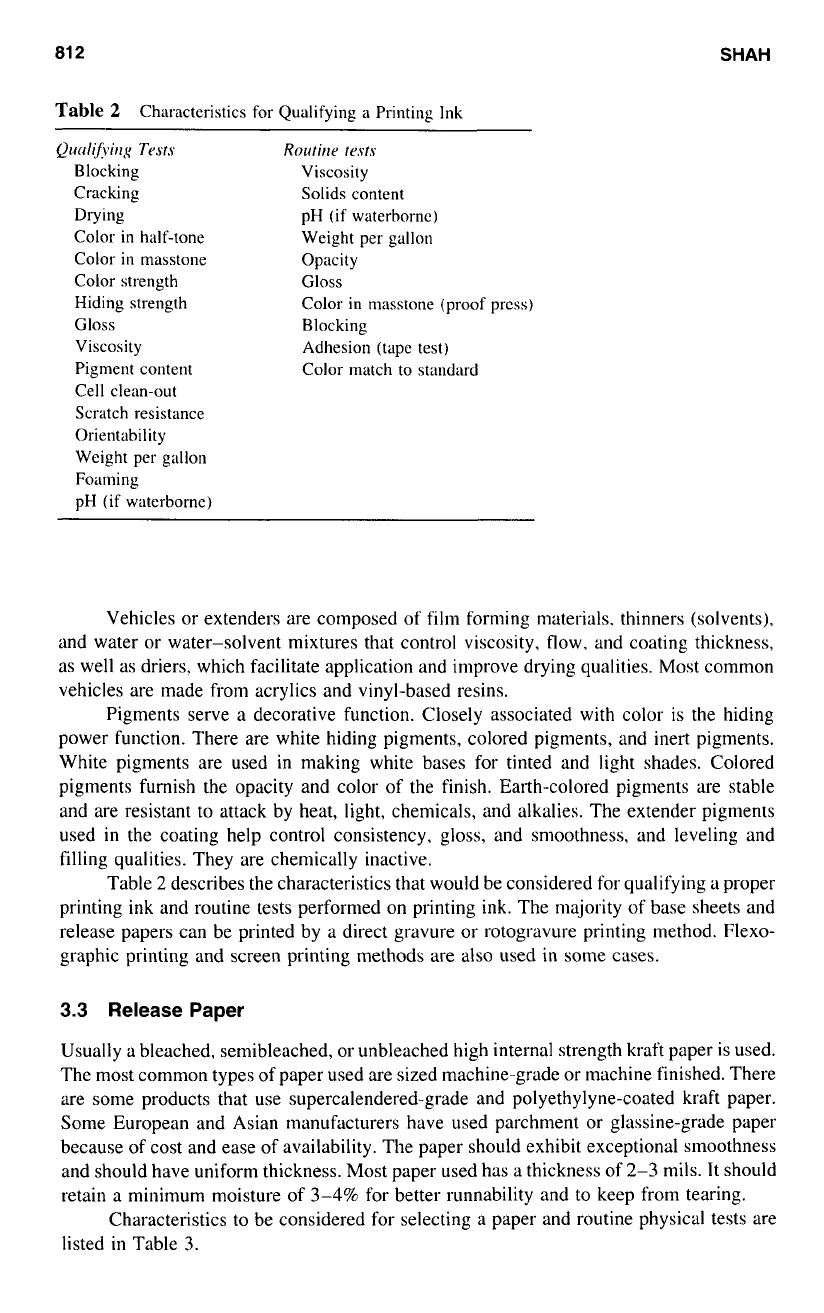
81
2
SHAH
Table
2
Characteristics for Qualifying
a
Printing Ink
Qucrlt'fiirtg
Tests
Routine tests
Blocking
Viscosity
Cracking
Solids content
Drying
pH (if waterbornc)
Color in half-tone
Weight per gallon
Color in masstone
Opacity
Color strength
Gloss
Hiding strength
Color in masstone (proof prcss)
Viscosity Adhesion (tape test)
Pigment content Color match
to
standard
Cell clean-out
Scratch resistance
Orientability
Weight per gallon
Foaming
pH (if waterborne)
Gloss
Blocking
Vehicles or extenders are composed of film forming materials. thinners (solvents).
and water or water-solvent mixtures that control viscosity, flow, and coating thickness,
as well as driers. which facilitate application and improve drying qualities. Most common
vehicles are made from acrylics and vinyl-based resins.
Pigments serve a decorative function. Closely associated with color is the hiding
power function. There are white hiding pigments, colored pigments, and inert pigments.
White pigments are used in making white bases for tinted and light shades. Colored
pigments furnish the opacity and color
of
the finish. Earth-colored pigments are stable
and are resistant to attack by heat, light, chemicals, and alkalies. The extender pigments
used
in
the coating help control consistency, gloss, and smoothness, and leveling and
filling qualities. They are chemically inactive.
Table
2
describes the characteristics that would be considered for qualifying a proper
printing ink and routine tests performed on printing
ink.
The majority
of
base sheets and
release papers can be printed by a direct gravure or rotogravure printing method. Flexo-
graphic printing and screen printing methods are also used in some cases.
3.3
Release
Paper
Usually a bleached, semibleached, or unbleached high internal strength kraft paper is used.
The most common types
of
paper used are sized machine-grade or machine finished. There
are some products that use supercalendered-grade and polyethylyne-coated kraft paper.
Some European and Asian manufacturers have used parchment or glassine-grade paper
because
of
cost and ease of availability. The paper should exhibit exceptional smoothness
and should have uniform thickness.
Most
paper used has a thickness
of
2-3
mils. It should
retain a minimum moisture of
3-4%
for better runnability and
to
keep from tearing.
Characteristics to be considered for selecting a paper and routine physical tests are
listed in Table
3.

DECORATIVE SURFACE PROTECTION PRODUCTS
81
3
Table
3
Criteria for Selecting a Release Paper
For
/>utter.
r-ur~rtd>ility
Tensile strength (dry and wet), in machine and cross
Moisture contcut
Elmendorf tear
Mullen burst strength
Porosity
Caliper
Basis weight
Sizing in paper for better silicone holdout
Surface finish for better printability
Heat resistance and shrinkage resistance for better
dimensional stability while drying coatings
Smoothness and porosity for better release coating
Good formation
to
minimize cockling tendency
Caliper
Basis weight
Mullen burst strength
Tensile strength in machine and cross dircctions
Tear strength in machine and cross directions
Surface smoothness
Porosity
Color
directions
For.
hettrr
cotrtcrbilih
Kolrtirze
plzy.sid
tests
otI
o
cllroli/ierl
ppr
3.4
Release Coatings
Silicones are the most widely used materials for release coating applications. They give
a low level
of
release and are useful for coating the release paper.
The basic chemistry and physical properties of silicone release coating is described
in detail by Mary
D.
Fey and John
E.
Wilson?
3.5
Pressure-Sensitive Adhesives
Although pressure-sensitive adhesive clearly takes a position
of
secondary importance
in
most products, careful selection of the adhesive should be an important function of a
researcher.
The main function
of
the adhesive
is
to provide affinity to both the release liner and
the base sheet used on these products. The adhesive should
allow
the base sheet enough
time
to
move around the surface before bonding permanently. Another important function
of the adhesive is
to
provide plasticizer migration resistance specifically when a plasticized
vinyl film is used as a base sheet.
Another method of demonstrating improved pressure-sensitive properties is to com-
pare the rate of buildup of peel adhesion to Garious surfaces with other candidates. The
adhesive should provide good heat and humidity resistance and also better shrinkage
resistance
in
the finished products.
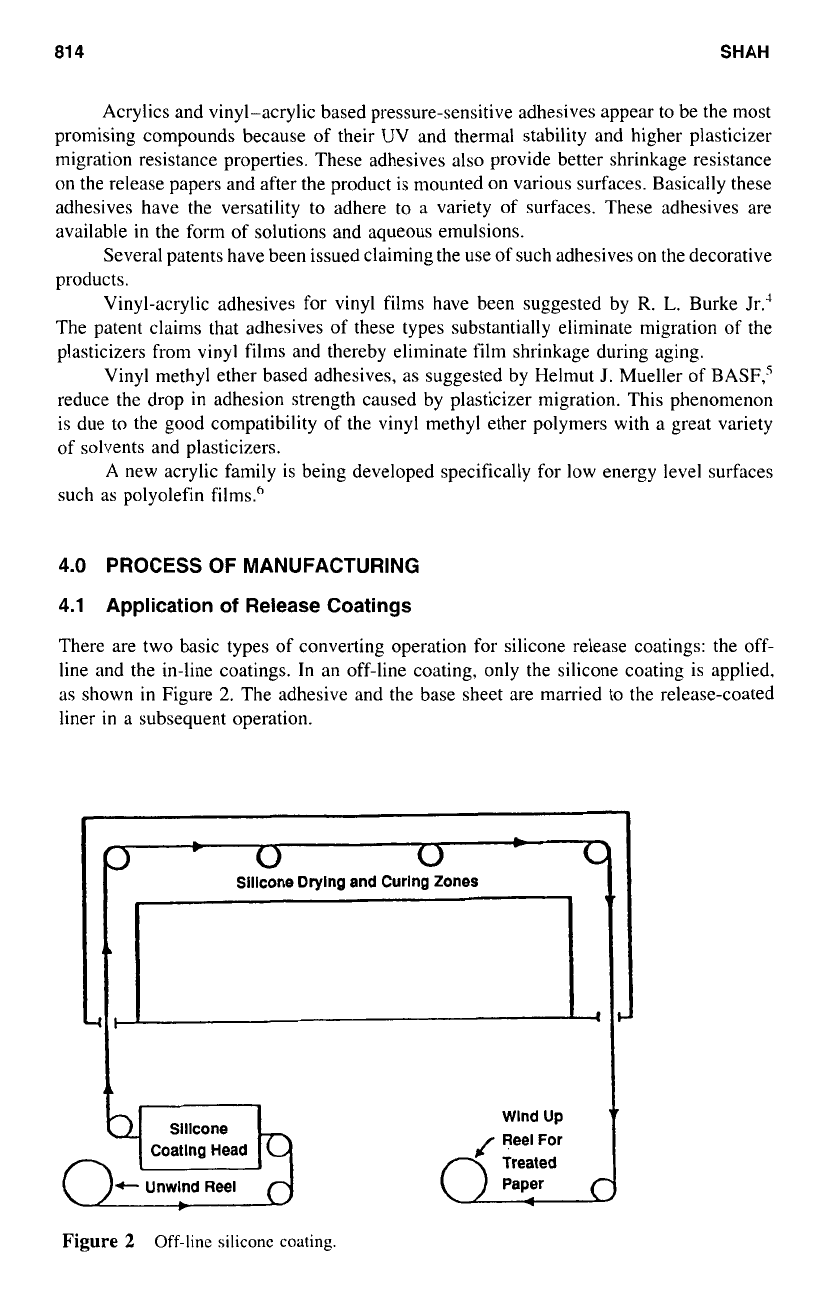
81
4
SHAH
Acrylics and vinyl-acrylic based pressure-sensitive adhesives appear to be the most
promising compounds because
of
their
UV
and thermal stability and higher plasticizer
migration resistance properties. These adhesives also provide better shrinkage resistance
on
the release papers and after the product is mounted
on
various surfaces. Basically these
adhesives have the versatility
to
adhere
to
a variety of surfaces. These adhesives are
available
in
the form of solutions and aqueous emulsions.
Several patents have been issued claiming the use of such adhesives on the decorative
products.
Vinyl-acrylic adhesives for vinyl films have been suggested by
R.
L.
Burke Jr.'
The patent claims that adhesives of these types substantially eliminate migration of the
plasticizers from vinyl films and thereby eliminate film shrinkage during aging.
Vinyl methyl ether based adhesives, as suggested by Helmut J. Mueller of BASF,'
reduce the drop in adhesion strength caused by plasticizer migration. This phenomenon
is due to the good compatibility of the vinyl methyl ether polymers with a great variety
of solvents and plasticizers.
A new acrylic family is being developed specifically for low energy level surfaces
such as polyolefin films.'
4.0
PROCESS
OF MANUFACTURING
4.1
Application
of
Release Coatings
There are two basic types of converting operation for silicone release coatings: the off-
line and the in-line coatings.
In
an off-line coating, only the silicone coating is applied,
as shown
in
Figure
2.
The adhesive and the base sheet are married to the release-coated
liner in a subsequent operation.
r
*L
sillcone
Coatlng Head
Wind Up
Treated
+-
Unwlnd
Reel
Paper
r
Silicone Drying and Curing Zones
l
Figure
2
Off-line siliconc coating.
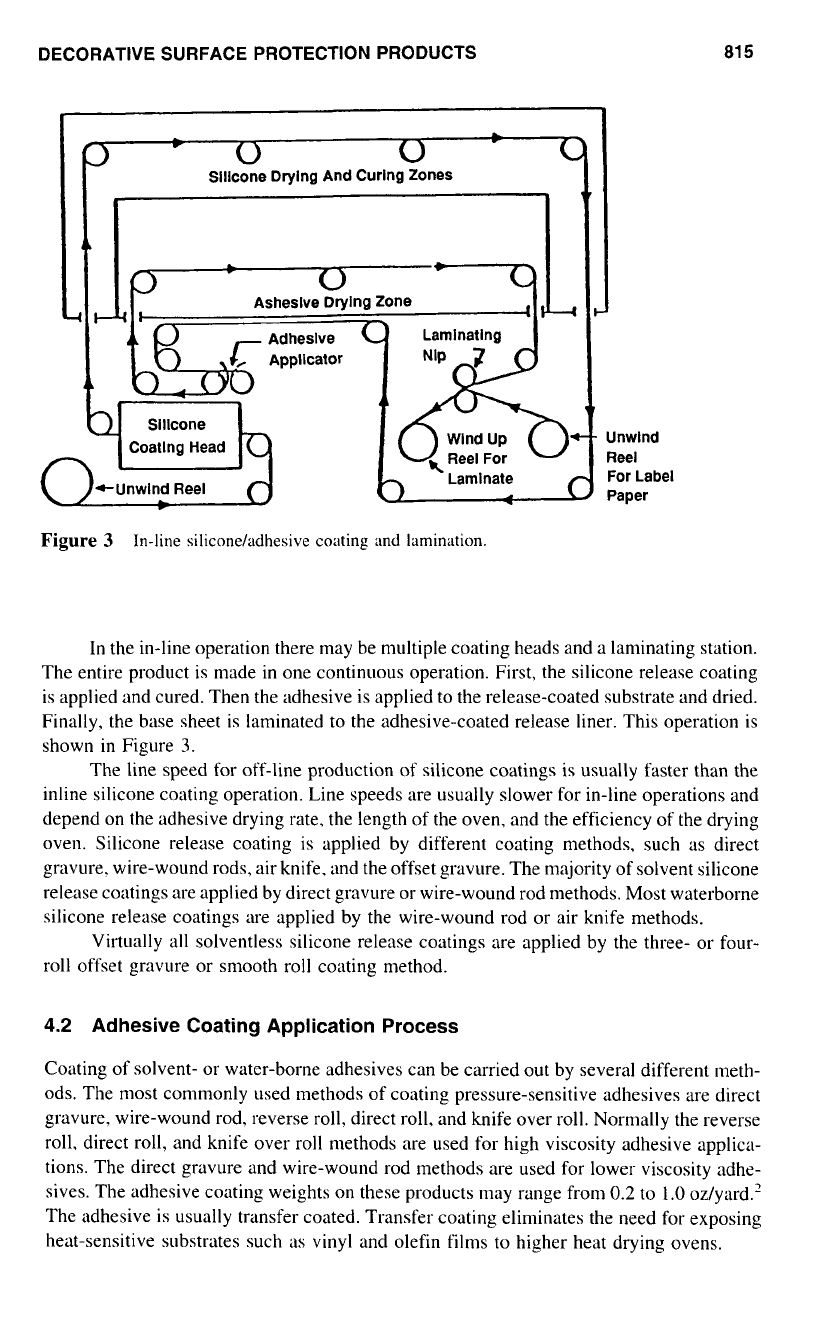
DECORATIVE SURFACE PROTECTION PRODUCTS
81
5
Figure 3
In-line silicone/adhesive coating
and
lamination.
In the in-line operation there may be multiple coating heads and
a
laminating station.
The entire product is made
in
one continuous operation. First, the silicone release coating
is applied and cured. Then the adhesive is applied
to
the release-coated substrate and dried.
Finally, the base sheet is laminated to the adhesive-coated release liner. This operation is
shown in Figure
3.
The line speed for off-line production
of
silicone coatings is usually faster than the
inline silicone coating operation. Line speeds are usually slower for in-line operations and
depend on the adhesive drying rate, the length
of
the oven, and the efficiency
of
the drying
oven. Silicone release coating is applied by different coating methods, such as direct
gravure. wire-wound rods, air knife. and the offset gravure. The majority of solvent silicone
release coatings are applied by direct gravure or wire-wound rod methods. Most waterborne
silicone release coatings are applied by the wire-wound rod or air knife methods.
Virtually all solventless silicone release coatings are applied by the three- or four-
roll offset gravure or smooth roll coating method.
4.2
Adhesive Coating Application Process
Coating of solvent- or water-borne adhesives can be carried out by several different meth-
ods. The most commonly used methods of coating pressure-sensitive adhesives are direct
gravure. wire-wound rod, reverse roll. direct roll. and knife over roll. Normally the reverse
roll, direct roll, and knife over roll methods are used for high viscosity adhesive applica-
tions. The direct gravure and wire-wound rod methods are used for lower viscosity adhe-
sives. The adhesive coating weights
on
these products may range from
0.2
to
1
.0
oz/yard.'
The adhesive
is
usually transfer coated. Transfer coating eliminates the need for exposing
heat-sensitive substrates such
as
vinyl and olefin films
to
higher heat drying ovens.
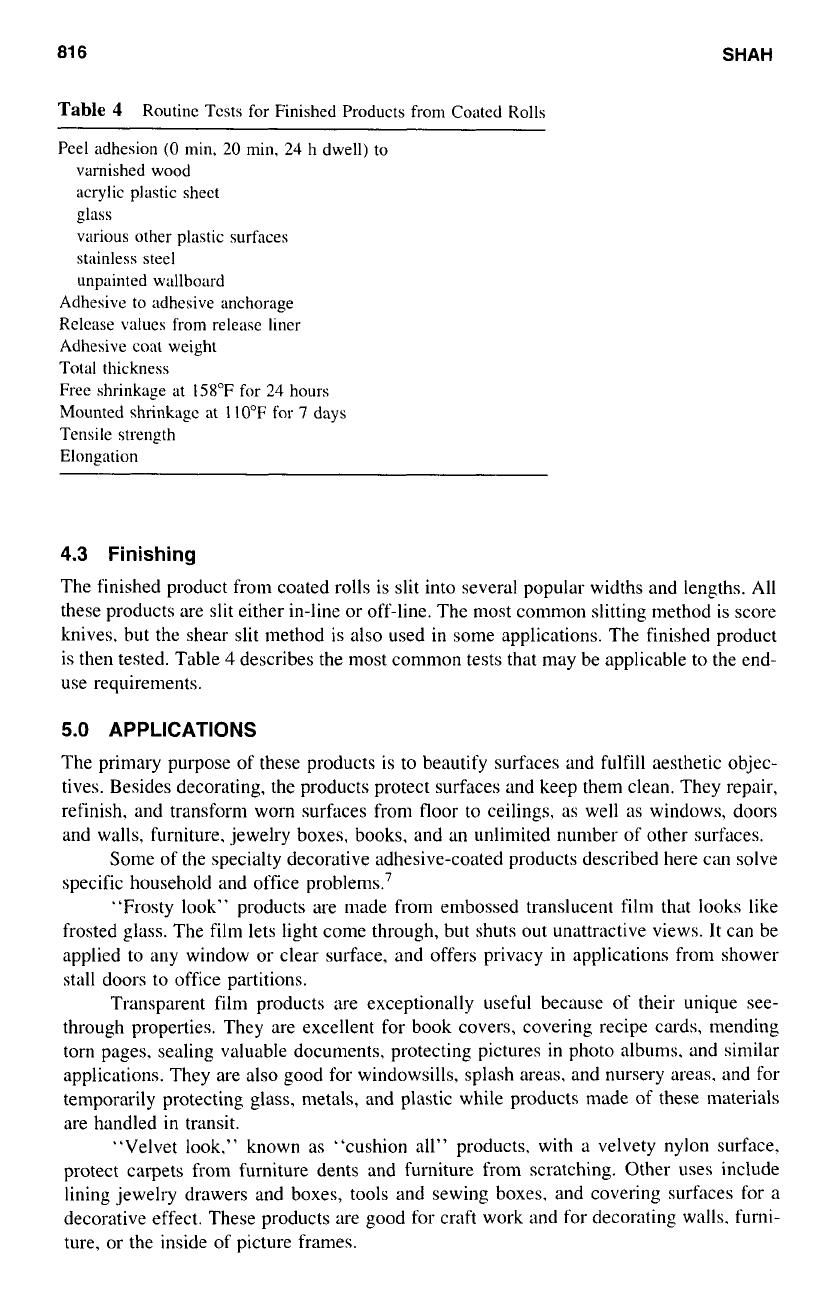
81
6
SHAH
Table
4
Routine Tests for Finished Products from Coated Rolls
Peel adhesion
(0
min.
20
min,
24
h
dwell) to
varnished wood
acrylic
plastic
sheet
various
other plastic surfaces
stainless
steel
unpninted
wallboard
glass
Adhesive to adhesive anchorage
Release values
from
release liner
Adhesive
coat
weight
Total
thickness
Free shrinkage
at
158°F
for
24
hours
Mounted shrinkagc
at
1
10°F
for
7
days
Tensile strength
Elongation
4.3
Finishing
The finished product from coated rolls is slit into several popular widths and lengths. All
these products are slit either in-line or off-line. The most common slitting method is score
knives, but the shear slit method is also used in some applications. The finished product
is then tested. Table
4
describes the most common tests that may be applicable
to
the end-
use requirements.
5.0
APPLICATIONS
The primary purpose of these products is
to
beautify surfaces and
fulfill
aesthetic objec-
tives. Besides decorating, the products protect surfaces and keep them clean. They repair,
refinish, and transform worn surfaces from floor
to
ceilings. as well as windows. doors
and walls, furniture. jewelry boxes, books, and an unlimited number
of
other surfaces.
Some of the specialty decorative adhesive-coated products described here can solve
specific household and office problems.’
“Frosty look” products are made from embossed translucent film that looks like
frosted glass. The film lets light come through, but shuts out unattractive views.
It
can be
applied to any window or clear surface. and offers privacy
in
applications from shower
stall doors to office partitions.
Transparent film products are exceptionally useful because
of
their unique see-
through properties. They are excellent for book covers, covering recipe cards, mending
torn pages. sealing valuable documents, protecting pictures
in
photo albums, and similar
applications. They are also good for windowsills, splash areas. and nursery areas. and for
temporarily protecting glass, metals, and plastic while products made
of
these materials
are handled
in
transit.
“Velvet look.” known as “cushion all’’ products, with
a
velvety nylon surface.
protect carpets from furniture dents and furniture from scratching. Other uses include
lining jewelry drawers and boxes, tools and sewing boxes. and covering surfaces for a
decorative effect. These products are good for craft work and for decorating walls. furni-
ture, or the inside
of
picture frames.
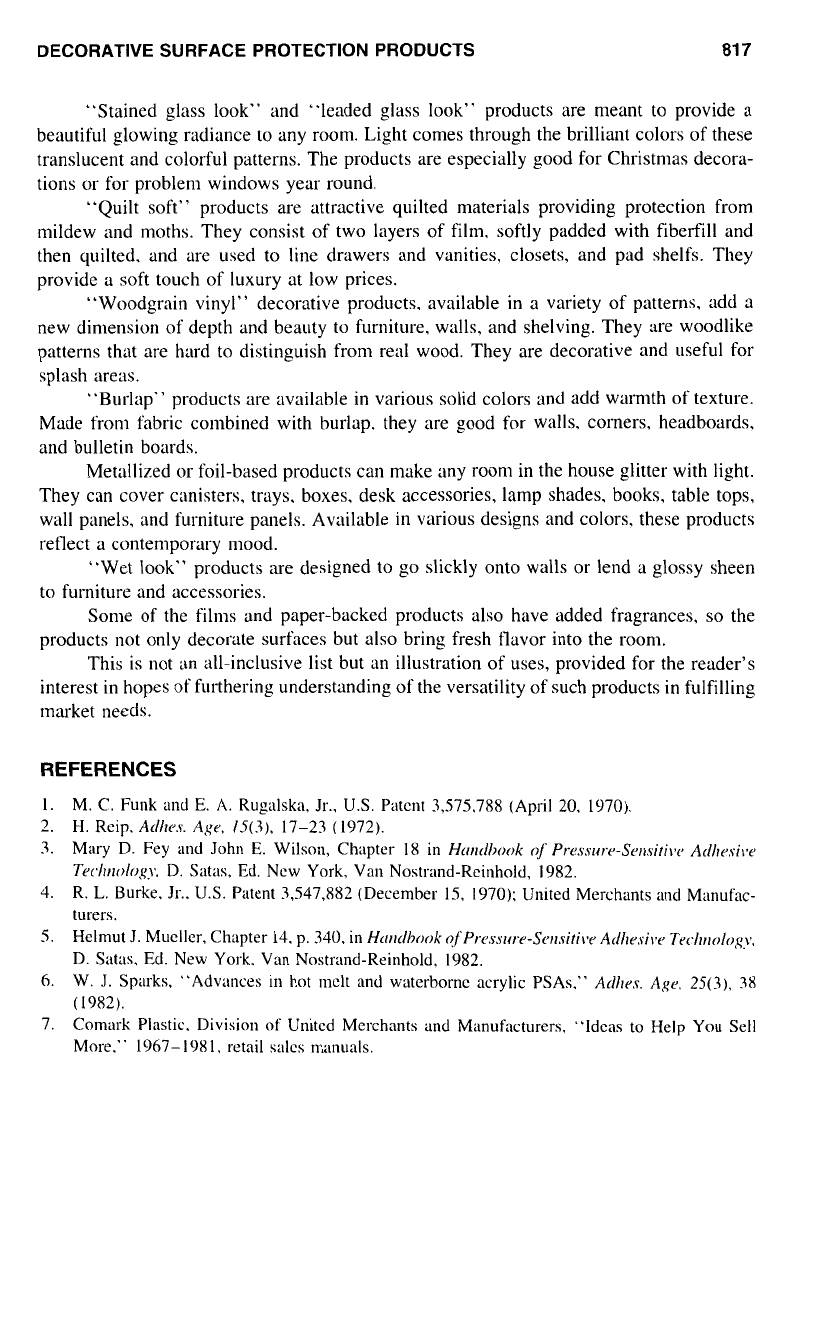
DECORATIVE SURFACE PROTECTION PRODUCTS
81
7
“Stained glass look” and “leaded glass look” products are meant
to
provide a
beautiful glowing radiance to any room. Light comes through the brilliant colors of these
translucent and colorful patterns. The products are especially good for Christmas decora-
tions or for problem windows year round.
“Quilt soft” products are attractive quilted materials providing protection from
mildew and moths. They consist
of
two layers
of
film, softly padded with fiberfill and
then quilted. and are used to line drawers and vanities, closets, and pad shelfs. They
provide a soft touch of luxury at low prices.
“Woodgrain vinyl” decorative products. available
in
a variety
of
patterns, add a
new dimension of depth and beauty to furniture. walls, and shelving. They are woodlike
patterns that are hard
to
distinguish from real wood. They are decorative and useful for
splash areas.
“Burlap” products are available in various solid colors and add warmth of texture.
Made from fabric combined with burlap. they are good for walls. corners, headboards,
and bulletin boards.
Metallized or foil-based products can make any room in the house glitter with light.
They can cover canisters, trays. boxes. desk accessories, lamp shades. books, table tops,
wall panels. and furniture panels. Available
in
various designs and colors, these products
retlect a contemporary mood.
“Wet look” products are designed
to
go slickly onto walls or lend a glossy sheen
to furniture and accessories.
Some of the films and paper-backed products also have added fragrances.
so
the
products not only decorate surfaces but also bring fresh flavor into the room.
This is
not
an all-inclusive list but an illustration of uses, provided for the reader’s
interest
in
hopes
of
furthering understanding
of
the versatility
of
such products in fulfilling
rnarket needs.
REFERENCES
I.
2.
3.
4.
S.
6.
7.
M.
C.
Funk
and
E.
A.
Rugalska,
Jr..
US.
Patent 3,575,788 (April 20, 1970).
H. Reip.
Adlws.
Age,
lS(3).
17-23
(
1972).
Mary
D.
Fey
and
John
E.
Wilson,
Chapter
1
X
in
Hmtlhook
oJ’
P,-c.s.su,-r-Serl.sitil,~,
Ad/wsi~*e
Techdogy.
D.
Satns,
Ed.
New York, Van Nostland-Reinhold,
19x2.
R.
L.
Burke. Jr..
U.S.
Patent 3,547,882 (December
IS.
1970); United Merchants
and
Manufac-
turers.
Helmut
J.
Mueller. Chapter
14.
p.
340.
in
Htrrrdlxwk
~f’P~e.s.s~r,-r-Ser~,~ifi~~~~Ad/~r,si~~p
Techrro/o,qy.
D. Satns.
Ed.
New York. Van Nostrand-Reinhold.
1982.
W.
J.
Sparks, “Advances in hot
melt
and waterborne acrylic PSAs.”
Arl1re.s.
A<ge.
25(3),
38
(
1982).
Comark Plastic. Division
of
United Merchants
and
Manufacturers, “Ideas to Help You Sell
More.” 1967-
1981.
retail
sales
nxunuals.
This Page Intentionally Left Blank
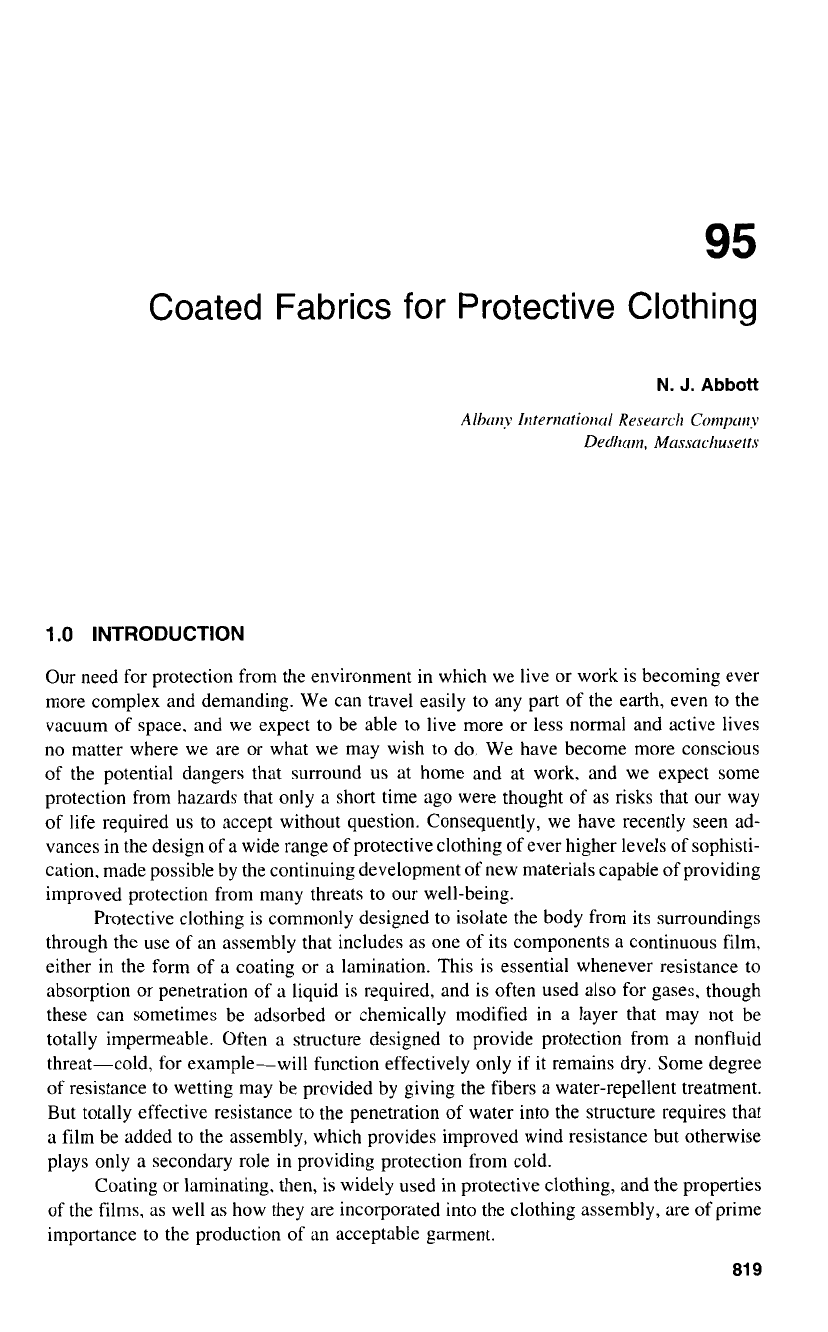
95
Coated Fabrics for Protective Clothing
1
.O
INTRODUCTION
Our need for protection from the environment in which we live or work is becoming ever
more complex and demanding. We can travel easily to any part of the earth, even
to
the
vacuum of space. and we expect to be able
to
live more or less normal and active lives
no matter where we are or what we may wish to do. We have become more conscious
of the potential dangers that surround
us
at home and at work. and we expect some
protection from hazards that
only
a short time ago were thought
of
as risks that our way
of
life required us to accept without question. Consequently, we have recently seen ad-
vances in the design of a wide range of protective clothing of ever higher levels of sophisti-
cation. made possible by the continuing development of new materials capable of providing
improved protection from many threats to our well-being.
Protective clothing is commonly designed to isolate the body from its surroundings
through the use of an assembly that includes as one of its components a continuous film,
either in the form of a coating or a lamination. This is essential whenever resistance to
absorption or penetration of a liquid is required, and is often used also for gases, though
these can sometimes be adsorbed or chemically modified
in
a layer that may not be
totally impermeable. Often a structure designed to provide protection from a nonfluid
threat-cold, for example-will function effectively only if it remains dry. Some degree
of resistance
to
wetting may be provided by giving the fibers a water-repellent treatment.
But totally effective resistance to the penetration
of
water into the structure requires that
a film be added to the assembly, which provides improved wind resistance but otherwise
plays
only
a secondary role in providing protection from cold.
Coating or laminating. then, is widely used in protective clothing, and the properties
of the films, as well as how they are incorporated into the clothing assembly, are
of
prime
importance to the production of an acceptable garment.
81
9
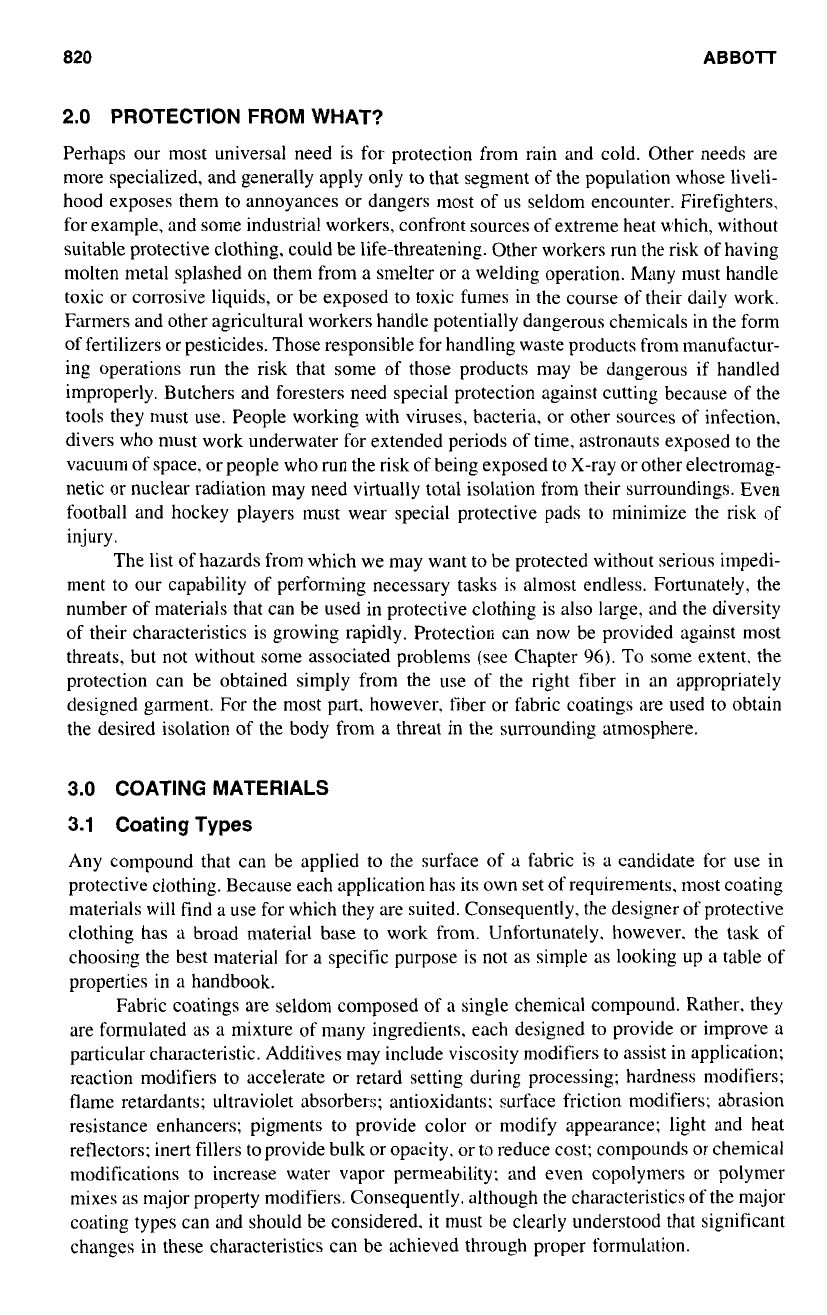
820
ABBOTT
2.0
PROTECTION FROM WHAT?
Perhaps our most universal need is for protection from rain and cold. Other needs are
more specialized, and generally apply only to that segment of the population whose liveli-
hood exposes them
to
annoyances or dangers most of
us
seldom encounter. Firefighters,
for example, and some industrial workers, confront sources of extreme heat which, without
suitable protective clothing, could be life-threatening. Other workers run the risk
of
having
molten metal splashed on them from a smelter or a welding operation. Many must handle
toxic or corrosive liquids, or be exposed to toxic fumes in the course
of
their daily work.
Farmers and other agricultural workers handle potentially dangerous chemicals
in
the form
of fertilizers or pesticides. Those responsible for handling waste products from manufactur-
ing operations run the risk that some of those products may be dangerous if handled
improperly. Butchers and foresters need special protection against cutting because of the
tools they must use. People working with viruses, bacteria, or other sources
of
infection.
divers who must work underwater for extended periods of time, astronauts exposed
to
the
vacuum of space. or people who run the risk of being exposed
to
X-ray or other electromag-
netic or nuclear radiation may need virtually total isolation from their surroundings. Even
football and hockey players must wear special protective pads
to
minimize the risk of
injury.
The list of hazards from which we may want
to
be protected without serious impedi-
ment to our capability of performing necessary tasks is almost endless. Fortunately, the
number
of
materials that can be used in protective clothing is also large, and the diversity
of their characteristics is growing rapidly. Protection can now be provided against most
threats, but not without some associated problems (see Chapter
96).
To
some extent, the
protection can be obtained simply from the use of the right fiber
in
an appropriately
designed garment. For the most part. however, fiber or fabric coatings are used
to
obtain
the desired isolation of the body from a threat in the surrounding atmosphere.
3.0 COATING MATERIALS
3.1
Coating Types
Any compound that can be applied to the surface
of
a
fabric is
a
candidate for use in
protective clothing. Because each application has its own set ofrequirements, most coating
materials will find a use for which they are suited. Consequently, the designer of protective
clothing has
a
broad material base to work from. Unfortunately. however, the task of
choosing the best material for a specific purpose is not as simple
as
looking up
a
table of
properties in a handbook.
Fabric coatings are seldom composed
of
a single chemical compound. Rather, they
are formulated as a mixture of many ingredients, each designed to provide or improve
a
particular characteristic. Additives may include viscosity modifiers to assist in application;
reaction modifiers to accelerate or retard setting during processing; hardness modifiers;
flame retardants; ultraviolet absorbers; antioxidants: surface friction modifiers; abrasion
resistance enhancers; pigments
to
provide color or modify appearance; light and heat
reflectors; inert fillers to provide bulk or opacity. or to reduce cost; compounds or chemical
modifications to increase water vapor permeability: and even copolymers or polymer
mixes as major property modifiers. Consequently. although the characteristics of the major
coating types can and should be considered, it must be clearly understood that significant
changes in these characteristics can be achieved through proper formulation.
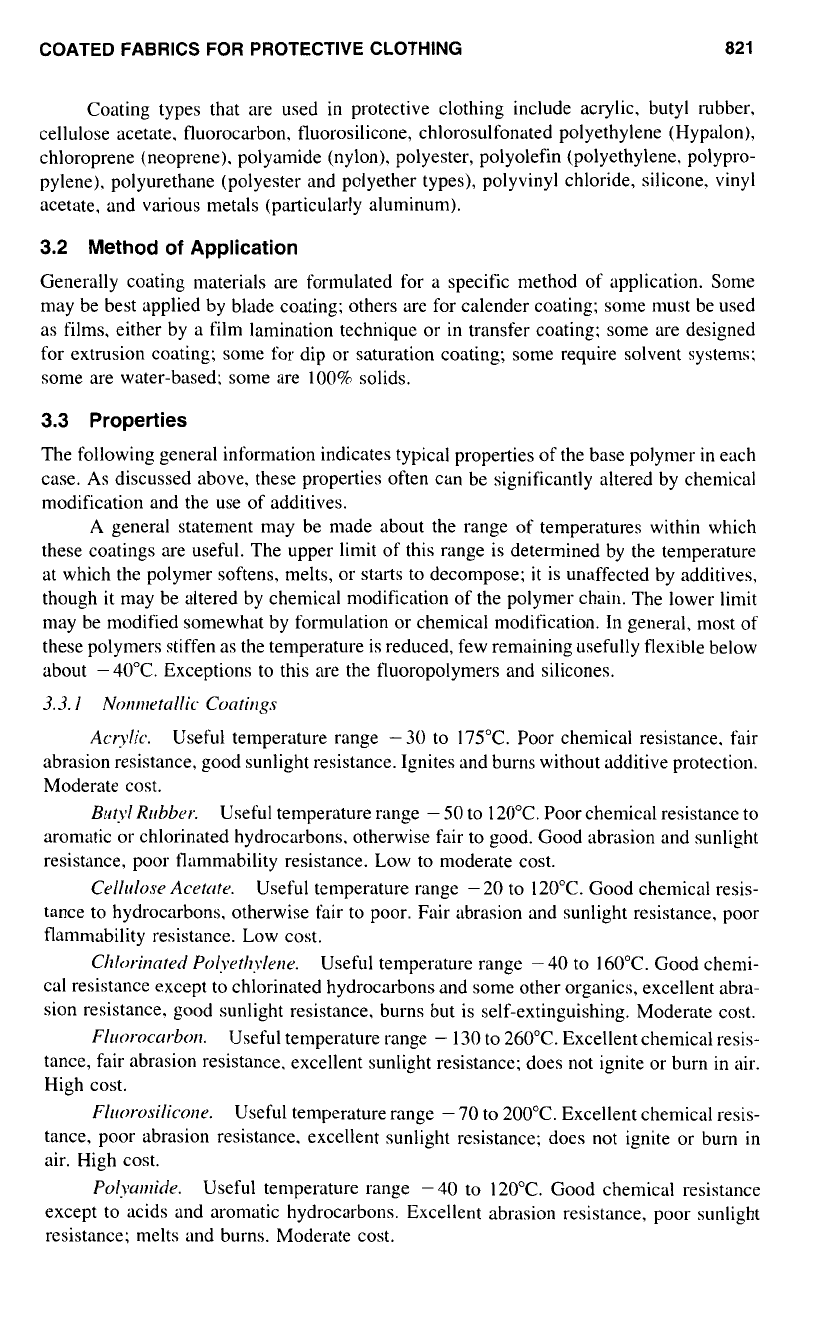
COATED FABRICS
FOR
PROTECTIVE CLOTHING
821
Coating types that are used
in
protective clothing include acrylic, butyl rubber.
cellulose acetate. fluorocarbon. tluorosilicone, chlorosulfonated polyethylene (Hypalon),
chloroprene (neoprene). polyamide (nylon). polyester, polyolefin (polyethylene, polypro-
pylene). polyurethane (polyester and polyether types), polyvinyl chloride, silicone.
vinyl
acetate. and various metals (particularly aluminum).
3.2 Method
of
Application
Generally coating materials are formulated for a specific method of application. Some
may be best applied by blade coating; others are for calender coating; some must be used
as films, either by a film lamination technique or in transfer coating; some are designed
for extrusion coating; some for dip or saturation coating; some require solvent systems;
some are water-based; some are
100%
solids.
3.3
Properties
The following general information indicates typical properties of the base polymer in each
case.
As
discussed above, these properties often can be significantly altered by chetnical
modification and the use of additives.
A
general statement may be made about the range of temperatures within which
these coatings are useful. The upper limit of this range is determined by the temperature
at which the polymer softens, melts, or starts
to
decompose;
it
is unaffected by additives,
though it may be altered by chemical modification of the polymer chain. The lower limit
may be modified somewhat by formulation or chemical modification.
In
general, most of
these polymers stiffen as the temperature is reduced, few remaining usefully tlexible below
about
-40°C.
Exceptions to this are the tluoropolymers and silicones.
3.3.
I
Nonr~~etullic Cocrtirlg.7
Acrylic.
Useful temperature range
-
30
to
175°C.
Poor chemical resistance. fair
abrasion resistance, good sunlight resistance. Ignites and burns without additive protection.
Moderate cost.
Butyl
Rlrhber.
Useful temperature range
-
50
to
120°C.
Poor chemical resistance to
aromatic or chlorinated hydrocarbons, otherwise fair to good. Good abrasion and sunlight
resistance, poor flammability resistance. Low to moderate cost.
Cellulose
Acetute.
Useful temperature range
-
20
to
120°C.
Good chemical resis-
tance to hydrocarbons. otherwise fair to poor. Fair abrasion and sunlight resistance, poor
flammability resistance. Low cost.
Chlorinc~ted
Polyrthylene.
Useful temperature range
-
40
to
160°C.
Good chemi-
cal resistance except
to
chlorinated hydrocarbons and some other organics, excellent abra-
sion resistance. good sunlight resistance, burns but
is
self-extinguishing. Moderate cost.
Fluorocurhon.
Useful temperature range
-
130
to
260°C.
Excellent chemical resis-
tance, fair abrasion resistance. excellent sunlight resistance; does not ignite or burn in air.
High cost.
Fllrorosilicone.
Useful temperature range
-
70
to
200°C.
Excellent chemical resis-
tance, poor abrasion resistance. excellent sunlight resistance; does
not
ignite or burn in
air. High cost.
Polyamide.
Useful temperature range
-
40
to
120°C.
Good chemical resistance
except to acids and aromatic hydrocarbons. Excellent abrasion resistance, poor sunlight
resistance; melts and burns. Moderate cost.
